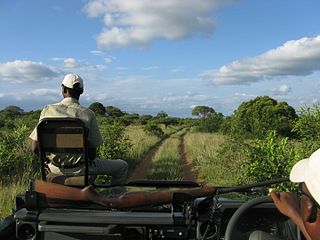
Phinda Private Game Reserve, formerly known as Phinda Resource Reserve, is a 170 km2 (66 sq mi) private game reserve situated in KwaZulu-Natal, South Africa, between the Mkuze Game Reserve and the iSimangaliso Wetland Park. Designated in 1990, Phinda is derived from a Zulu phrase "Phinda Izilwane" meaning 'do again', or more poetically 'return of wildlife'.

The Matobo National Park forms the core of the Matobo or Matopos Hills, an area of granite kopjes and wooded valleys commencing some 35 kilometres (22 mi) south of Bulawayo, southern Zimbabwe. The hills were formed over 2 billion years ago with granite being forced to the surface; it has eroded to produce smooth "whaleback dwalas" and broken kopjes, strewn with boulders and interspersed with thickets of vegetation. Matopo/Matob was named by the Lozwi. A different tradition states that the first King, Mzilikazi Khumalo when told by the local residents that the great granite domes were called madombo he replied, possible half jest, "We will call them matobo" - an Isindebele play on 'Bald heads'.

The Kerala backwaters are a network of brackish lagoons and canals lying parallel to the Arabian Sea of the Malabar coast of Kerala state in south-western India. It also includes interconnected lakes, rivers, and inlets, a labyrinthine system formed by more than 900 km (560 mi) of waterways, and sometimes compared to bayous. The network includes five large lakes linked by canals, both man made and natural, fed by 38 rivers, and extending virtually half the length of Kerala state. The backwaters were formed by the action of waves and shore currents creating low barrier islands across the mouths of the many rivers flowing down from the Western Ghats range. In the midst of this landscape there are a number of towns and cities, which serve as the starting and end points of backwater cruises. There are 34 backwaters in Kerala. Out of it, 27 are located either closer to Arabian Sea or parallel to the sea. The remaining 7 are inland navigation routes.
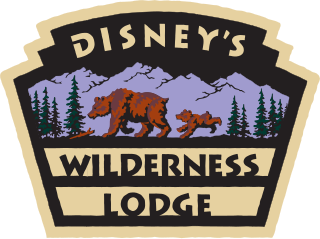
Disney's Wilderness Lodge is a resort hotel located at the Walt Disney World Resort in Lake Buena Vista, Florida. Opened on May 28, 1994, the resort is owned and operated by Disney Parks, Experiences, and Products. Disney's Wilderness Lodge is located in the Magic Kingdom Resort Area on Bay Lake. The resort is located near Disney's Fort Wilderness Resort & Campground. A similarly themed resort, Disney's Grand Californian Hotel & Spa, is located at the Disneyland Resort in California.

The Kandersteg International Scout Centre (KISC) is an international Scout centre in Kandersteg, Switzerland. The centre provides lodges, chalets and campsites covering 17 hectares of land. It is open to Scouts year round, as well as to non-Scouts for most of the year. More than 17,000 young people from over 50 countries visit the centre every year.

The Lake McDonald Lodge is a historic lodge located within Glacier National Park, on the southeast shore of Lake McDonald. The lodge is a 3+1⁄2-story structure built in 1913 based on Kirtland Cutter's design. The foundation and first floor walls are built of stone, with a wood-frame superstructure. The lobby is a large, open space that extends to the third story. It has a massive fireplace and a concrete floor scored in a flagstone pattern, with messages in several Indian languages inscribed into it. The rustic lodge was designated a National Historic Landmark in 1987 as one of the nation's finest examples of large-scale Swiss chalet architecture. Lake McDonald Lodge is a member of Historic Hotels of America, the official program of the National Trust for Historic Preservation.

The Lake McDonald Lodge Historic District is a historic district in Glacier National Park in the U.S. state of Montana. It comprises the Lake McDonald Lodge and surrounding structures on the shores of Lake McDonald. It is centered on the main lodge, which was designated a National Historic Landmark in 1987, as well as surrounding guest cabins, dormitory buildings, employee residences, utility buildings, and retail structures. The district includes several privately owned inholding structures that are contributing structures, as well as a number of non-contributing buildings.

Skukuza, a town in Mpumalanga located 57 km east of Hazyview at the confluence of the N'waswitshaka and Sabie Rivers, is the administrative headquarters of the Kruger National Park.

Nsumbu National Park lies on the western shore of Lake Tanganyika near its southern extremity, in Zambia's Northern Province. It covers about 2000 km2 and has some 80 km of lake shore including four bays, and Nundo Head Peninsula.
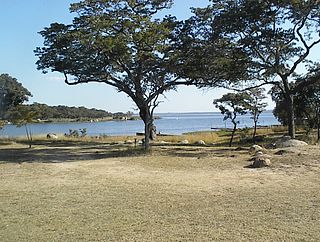
Lake Chivero is a reservoir on the Manyame River in Zimbabwe.

Lake Elmenteita is a soda lake, in the Great Rift Valley, about 120 km northwest of Nairobi, Kenya.

The wildlife of Zimbabwe occurs foremost in remote or rugged terrain, in national parks and private wildlife ranches, in miombo woodlands and thorny acacia or kopje. The prominent wild fauna includes African buffalo, African bush elephant, black rhinoceros, southern giraffe, African leopard, lion, plains zebra, and several antelope species.

Moose Mountain Provincial Park is a provincial park, in south-eastern Saskatchewan about 24 kilometres (15 mi) north of the town of Carlyle on the Moose Mountain Upland. It is one of Saskatchewan's few parks with a community inside the park as there are several subdivisions with both year-round and seasonal residents. The village of Kenosee Lake is completely surrounded by the park but is not part of the park.
With an area of 135km² Mwabvi Wildlife Reserve is Malawi’s smallest national park, and its least accessible. Nevertheless, it has a wide variety of habitats, including Mopane, Combretum and brachystegia woodland, as well as open savanna, dambo, and riverine areas. Mwabvi was the last natural home to Malawi's Black Rhino population, but both wildlife and woodland have been poached over recent years. However many species of antelope, including kudu, sable, impala and nyala, are present, and even leopard and hyena have been seen. Buffalo still bathe in the Mwabvi river, and, although the number of human tourists is low, lions from neighbouring Mozambique are regular visitors. The scenery is spectacular, with views over the Shire River and the Zambesi river, and the magnificent sandstone outcrops give an almost lunar feel to the landscape.

The Great Northern Railway Buildings are a set of five building complexes in or near Glacier National Park in Montana. They were built by the Great Northern Railway during the period of the park's founding to provide a unified tourist experience to visitors to the park, using the Swiss chalet as a building model. The building complexes, each separately listed on the National Register of Historic Places, are:
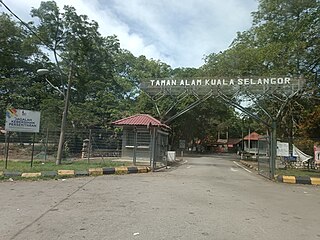
The Kuala Selangor Nature Park is a park located by the mouth of the Selangor River in Kuala Selangor District, Selangor, Malaysia. It was established by the Selangor state government in 1987 and has been managed by the Malaysian Nature Society which has proposed that it be declared a wetland of international importance.

Bao BolongWetland Reserve is a protected area in The Gambia. Established in 1996, it covers 296.5 square kilometres.
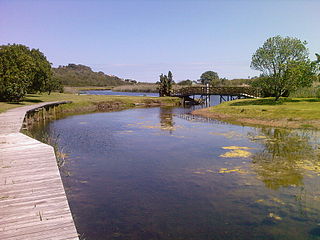
Wilderness National Park, also called the Wilderness Section, is located around the seaside town of Wilderness between the larger towns of George and Knysna, in the Western Cape. It is a protected area of South Africa forming part of the Garden Route National Park.
Sleepy Hollow Lake is both a recreational lake and residential community in Greene County, New York, United States, located 120 miles north of New York City and 28 miles south of Albany in the Hudson River Valley. The lake is a two and one-half mile long, 324 acre, 70 foot deep man-made, Class “A” drinking water reservoir for the neighboring communities. It is surrounded by a 2,200 acre residential community, also known as “Sleepy Hollow Lake”, which is a Planned Unit Development (PUD) that self-governs residential land use, maintains common roads, parks, beaches, and other recreational facilities, operates most of the development's sewer and water services, and provides community security and code enforcement. The community is within the viewshed of the Taconic Mountains to the east and the Catskill Mountains to the west. The community was featured in a 2015 episode of the HGTV series Lakefront Bargain Hunt.
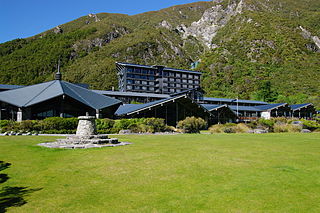
The Hermitage Hotel in Mount Cook Village, New Zealand, is a hotel located inside the Aoraki / Mount Cook National Park, 65 kilometres (40 mi) north of Twizel. The current building dates from 1958 and forms the main part of Mount Cook Village, being the only large building. Along with a nearby lodge and motels, the hotel trades as Aoraki Mt Cook Alpine Village and is owned by Trojan Holdings.





















